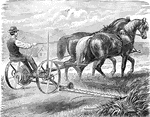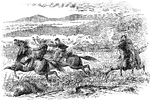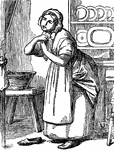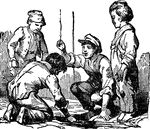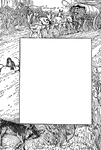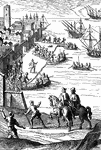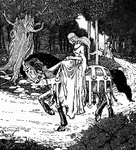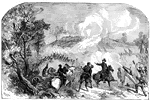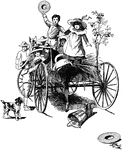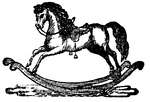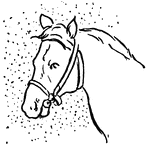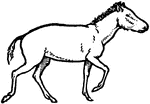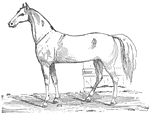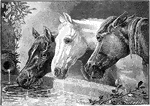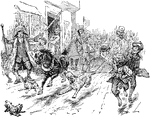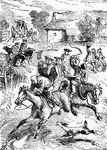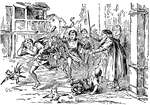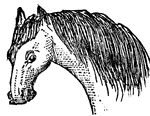
Horse Breeds
Different types of horse breeds. Left is a draft horse, middle is a Shetland pony, and the right is…

Commencement of Bull Run
"The Confederate forces under General Jackson advancing upon the Rapphannock Station at the river. Federal…
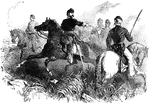
General Burnside
"Major General Burnside assuming command of the Army of the Potomac- issuing orders to his staff. 'Headquarters,…
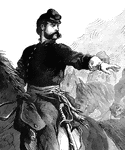
General Burnside
"Major General Burnside assuming command of the Army of the Potomac- issuing orders to his staff. 'Headquarters,…

Stuart's Cavalry
"Stuart's Confederate Cavalry, after their successful raid into Pennsylvania, escaping with their stolen…
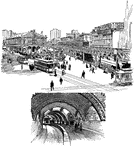
City Transportation
"Transportation in a large city, showing elevated road, surface line, and subway." -Gordy, 1916
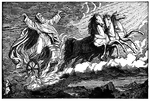
Elijah Taken up to Heaven in a Chariot of Fire and a Whirlwind
"And it came to pass, as they still went on, and talked, that, behold, there appeared a chariot of fire,…
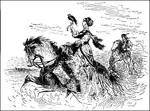
Falconry as Practiced by a Noblewoman of the Middle Ages on Horseback
A high-born, noblewoman rides a stallion while holding a falcon perched on her right hand. She is wearing…

The Story of the Glittering Plain
This is an illustration by artist Walter Crane of the Story of the Glittering Plain by writer William…
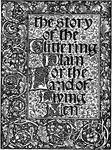
The Story of the Glittering Plain
An illustration by Walter Crane; featuring the Story of the Glittering Plain by Morris. Depicts, three…

Hames
The curved pieces of wood or metal by which the traces and body-harness of a horse are attached to the…
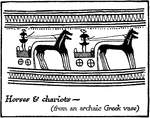
Aryan Speaking People, Horses and Chariots
From an archaic Greek vase, a picture of horses and chariots.
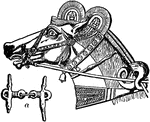
Horse Bridle and Bit
"Bridle and Bit, that part of a horse's harness which is attached to the head and mouth, by means of…

Horseback Riding
An illustration of a man riding a horse on a trail talking to a young man walking beside him. There…
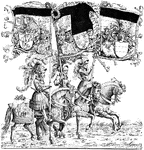
Horsemen, Three Abreast, with Banners
Horsemen, Three Abreast, with Banners, from the engraving 'The Triumphal Procession' by Hans Burgkmair.
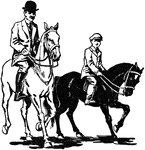
Man and Boy Riding Horses
An illustration of a man riding a white horse and a boy riding a black horse.
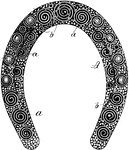
Horseshoe
A horseshoe is a U-shaped item made of metal or of modern synthetic materials, nailed or glued to the…

Horseshoe Calk
A horseshoe is a U-shaped item made of metal or of modern synthetic materials, nailed or glued to the…
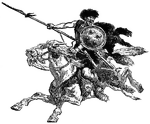
Hun Warrior on Horseback in Battle
Illustration of a Hun warrior riding on horseback, his mouth open as if to scream. The warrior has a…

Joseph Greets His Father Jacob and His Family
"And Joseph made ready his chariot, and went up to meet Israel his father, to Goshen; and he presented…
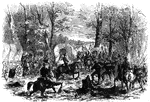
Lick Creek Bottom
"Advance of Federal troops on Corinth- the Carnival of Mud- scene at Lick Creek Bottom, between Pittsburg…
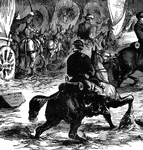
Lick Creek Bottom - Horse and Rider
"Advance of Federal troops on Corinth- the Carnival of Mud- scene at Lick Creek Bottom, between Pittsburg…
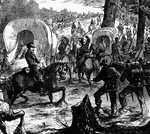
Lick Creek Bottom - In the Mud
"Advance of Federal troops on Corinth- the Carnival of Mud- scene at Lick Creek Bottom, between Pittsburg…
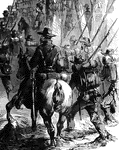
Lick Creek Bottom - Marching through the Mud
"Advance of Federal troops on Corinth- the Carnival of Mud- scene at Lick Creek Bottom, between Pittsburg…

Manure Spreader
A manure spreader in operation. The manure was pitched from the stable to the spreader, handled only…
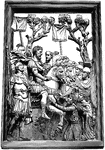
Marcus Aurelius and German Captives
"Marcus Aurelius receiving the submission of German captives. (From a Bas-relief in the Capitoline Museum,…




